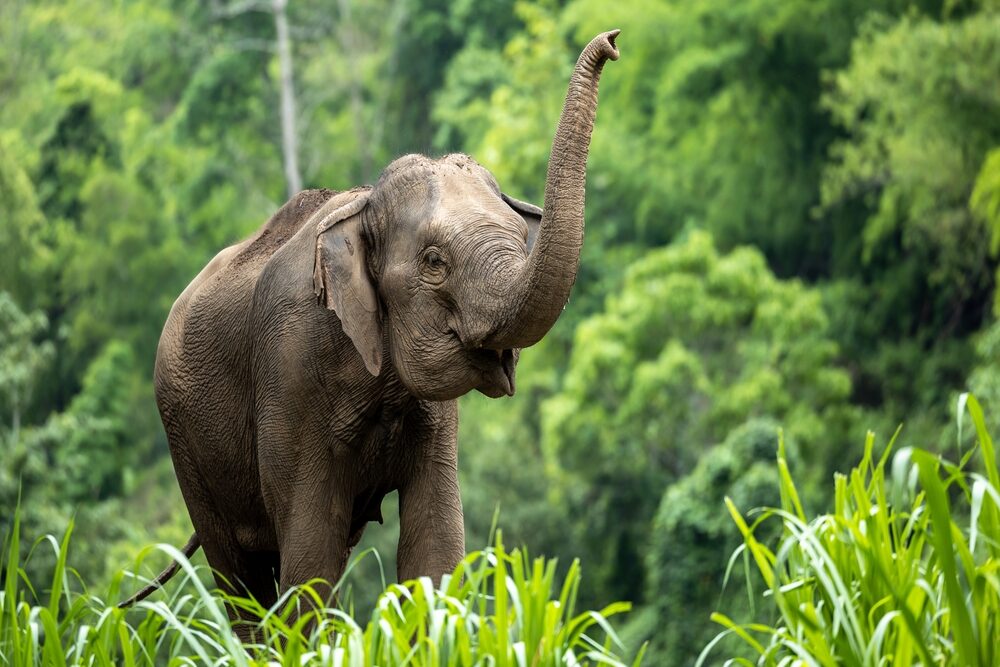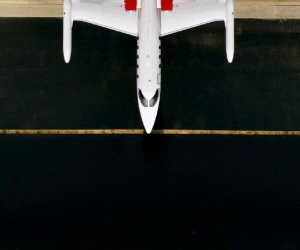Southeast Asia: Insider’s Guide
 Halong Bay, Vietnam: “The beauty of the country is simply astonishing.” Photo: Shutterstock
Halong Bay, Vietnam: “The beauty of the country is simply astonishing.” Photo: Shutterstock
The insider advice on this page is from one of Wendy’s Trusted Travel Experts for Southeast Asia: Sandy Ferguson and Ethan Crowley of Asia Desk.
Sandy and Ethan craft tailor-made itineraries that take travelers to multiple destinations in Southeast Asia and combine five-star creature comforts with authentic local experiences. Both grew up in the region: Sandy graduated from the International School of Bangkok in 1969 while his father was serving in the Vietnam war and has planned trips to the region for more than 30 years; Ethan was raised in Cambodia and is fluent in Khmer. Sandy now splits his time between Saigon and the U.S., while Ethan keeps the office running in South Carolina. This team is always candid about what works best for travelers, and, just as important, what doesn’t. They have a vast network of powerful contacts in the hotel industry—which translates into status for you—and a wonderful selection of on-the-ground hosts, all charismatic locals whom Sandy considers family (some of them really are!).
What to See and Do

A real floating market in Vietnam—not just one staged for tourists. Photo: C. Kennerly
Don’t miss
Mekong Delta, Vietnam. Many people have heard that Saigon (the French district of Ho Chi Minh City) is boring and not worth a visit, but in fact it’s one of Asia’s most civilized cities, and it’s small enough that you can see it all in a day. If you have more time, make the three-and-a-half-hour drive to Can Tho, the biggest city in the Mekong Delta (Asia’s breadbasket), and the next morning experience a real floating market—not staged like you’ll find in Thailand. Delta folks are among the friendliest in the country, and the region offers an outstanding variety of cuisines.
For a throwback to a bygone era when travel was slow and the world was simpler, journey down the Mekong River from Thailand into Luang Prabang. Board a private, ten-meter Lao-style river boat crewed by a local family and cruise through the mist-shrouded hill country to northern Laos on a trade route that has been in use for millennia. Overnight in quaint Pak Bang at a charming boutique hotel. If this sort of adventure appeals, hurry! Several proposed dams may soon make this river journey truly a thing of the past.
Hidden gem
Southern Laos, a paradise known as “Four Thousand Islands.” With the arrival of quality accommodations such as the River Resort in Champasak, visiting the mysterious pre-Angkorian 10th-century temple of Vat Phou, the islands of Don Khong and Don Khone, the Tad Somphamit (Liphi) waterfall, the famed Irrawaddy River dolphins, and the other attractions of the region is now a lot more comfortable. Spend a day visiting the Bolaven Plateau, where Laos’ best coffee is grown, and observe authentic hill tribe culture.
Cheap thrill
Every weekend in Hanoi, the circular road around Hoan Kiem Lake is closed to vehicular traffic. The area fills with performances by local musicians, full stage shows in the park next to the post office, an array of traditional Vietnamese family games, and vendors of all sorts. Hanoians turn out in full force for the event, with entire multigenerational families attending together, making it a wonderful cultural experience for visitors as well.
If you are headed to the beach in Cambodia, make the journey from Phnom Penh to Sihanoukville by train and step back in time. Tickets are less than $10, but this slow roll through the bucolic countryside is priceless.
Most overrated places
Phuket, Thailand has great beaches, but it’s overdeveloped and rife with traffic jams and mass-market tourist scams. Amanpurii and The Surin share a lovely private beach on Pansea Bay, but that’s about the only place you’d want to go. Instead, consider Koh Lanta.
Halong Bay gets a bad rap these days for overcrowding, and rightly so. If you choose a standard cruise, you may be surprised each night to see 20 to 40 other cruise ships anchored within earshot. In-the-know travelers skip the northern part of the bay and instead choose one of a handful of vessels that are registered to venture into the less-visited southern part. You’ll enjoy this gorgeous landscape in relative peace—and have the opportunity to visit the area around Cat Ba Island National Park, which is spectacular.

The Royal Palace of Cambodia in Phnom Penh. Photo: Ethan Crowley
Most underrated place
Phnom Penh, the capital city of Cambodia, often gets maligned on travel blogs. But if you know the city well (and Ethan and Sandy do), it’s one of the region’s overlooked gems. It manages to impart old-world charm through its unusual blend of Art Deco, French Colonial, and New Khmer architecture. Sandy and Ethan can arrange for a walking tour around the old city to learn about its pre-war golden age in the 1960s and to sample new Khmer cuisine, and a cooking class in a private villa with Phnom Penh’s first celebrity chef, who is working to revive nearly forgotten recipes. They also recommend a visit to the genocide museum—tough but essential to an understanding of modern Cambodia.
Bragging rights
Only Sandy and Ethan can arrange for you to see sunrise at Phnom Krom Pagoda in Siem Reap, which sits on a hill overlooking the Tonle Sap Lake and Angkor Wat. Depart from your hotel just after 4 a.m. to join the monks at the pagoda for their morning prayers and meditations. The abbot is an old friend of Sandy’s and you will meet him just before dawn, as the monks begin a purification ceremony that includes chanting, prayers, a sermon (which your guide translates), and a final blessing with holy water. The ceremony concludes just as the sun has risen and spreads light throughout the Angkor plain, with the great lake and temples of Angkor in sight. Step out of the temple to a picnic breakfast that is waiting for you on an excellent perch overlooking it all.
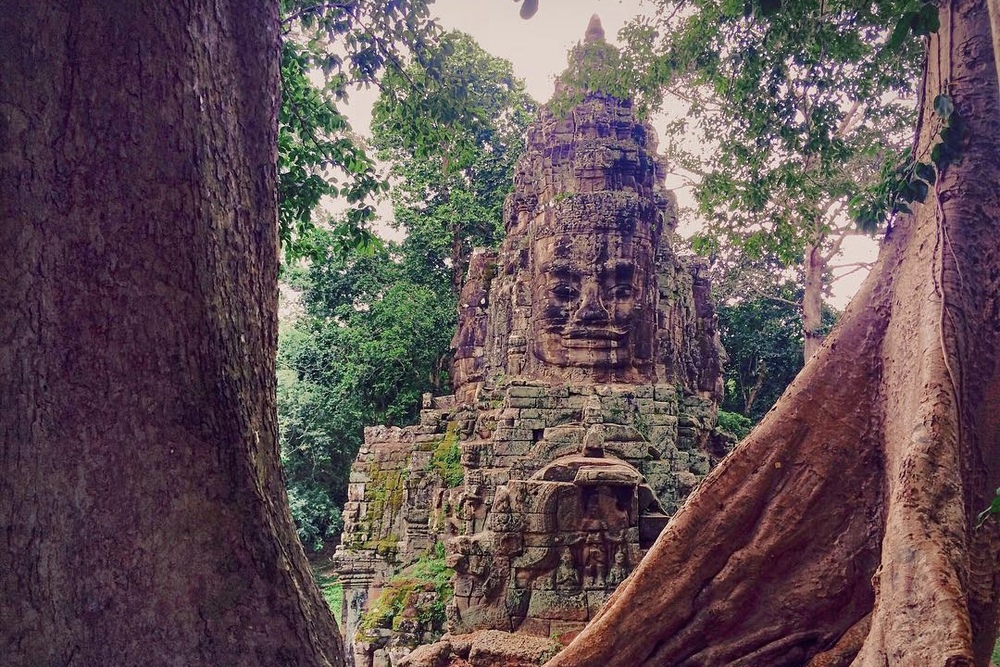
Angkor Thom temple, outside Siem Reap, emerges from the thick jungle. Photo: Ethan Crowley
Spend the morning (or day) with one of Cambodia’s top archaeologists, who is an expert on Angkor and has been featured in documentaries by the BBC, National Geographic, and CNN. Board a private helicopter and visit remote jungle temples in true “Indiana Jones” style. Your archaeologist guide may even bring charts of recently discovered sites that have not been made public (to discourage potential looting).
Downtime
Start early in the morning at the fresh market in Kep-sur-Mer, Cambodia and spend the rest of the day cooking with expert guidance at the Knai Bang Chatt Resort, until it’s time to eat the fruit of your labors. After the meal, a hammock will do you right in this colonial-era seaside resort, just down the Cambodian coast from Kampot and Sihanoukville. Kep, which has the feel of an old colonial ghost town replete with casino, has no beach; there is instead a grand breakwater that stretches the length of the old town. The Gulf of Thailand forms a bay here with Kep on one side and the Vietnamese island of Phu Quoc on the other, so the water is as calm as a lake, with many piers jutting out.
Where to Stay and Eat
Best-value splurge hotels
Mandarin Oriental Bangkok. This is without a doubt one of the finest historic hotels in Asia and the best value you will find at the luxury end of the spectrum—it may be expensive, but you get so much more here than you would for the same price in London, New York, or Tokyo. The service is better than in most top-notch European hotels, because the Mandarin Oriental pays well and retains talent; everyone on the staff takes a lot of pride in the place. The hotel also has a great location right on the river (wherever you stay in Bangkok, make sure it’s on the Chao Phraya). The Deluxe rooms in the River Wing are just fine, but if you want the prime view, book one of the eight Staterooms, which face the river head-on.

A lantern-lit dinner by the pool at Amantaka. Photo: Ryan Damm
Rarely are Aman properties considered “good value,” but the Amantaka in Luang Prabang is surely one of the best-value Amans in the world, with low-season rates occasionally below $1,000 per night. If you’ve been hankering to sample the famed Aman hospitality but were hesitant due to price, this might be your chance.
Best for wildlife lovers
With design inspired by Jackie Kennedy’s 1967 trip to Cambodia, the Shinta Mani Wild offers an experience like none other in Southeast Asia. This riverside luxury tented camp occupies a 865-acre valley on the southern border of the Cardamom National Forest. Situated at the intersection of three national parks, which contain some of Southeast Asia’s most remote jungle and herds of wild elephant, Malayan sun bears, gibbons, clouded leopards, Indian civets, guar, and pangolins, Shinta Mani Wild promises to preserve the forest from loggers and miners and to protect its wildlife from poaching.
Restaurant the locals love
Charin, a family-run restaurant on the river road from Chiang Mai to Chiang Rai, serves the best pies (yes, pies) you will ever taste. Owner Khun Charin, who is in her 90s, spent more than 20 years living in San Diego and developing her baking skills before returning to Thailand to open this place. All of her ingredients—including pumpkins for the absolute best pumpkin pie in the world—are organically grown in her garden.
Dishes to try
Khao soi is a simple northern Thai/Lao/Burmese curried chicken or beef soup with hearty noodles, coconut milk, and a rich depth of flavor. Be sure to throw in the deep-fried crispy egg noodles, pickled cabbage, and shallots, and squeeze a lime over it all.
Bánh xèo—literally “sizzling cake,” named for the loud sound it makes when the rice batter is poured into the hot skillet—is a Vietnamese savory fried pancake (it resembles a French crepe with a crispy edge) made of rice flour, water, and turmeric powder, and stuffed with slivers of fatty pork, shrimp, diced green onion, and bean sprouts. They are served wrapped in mustard leaf or lettuce leaves, and stuffed with mint leaves, basil, fish leaf, and other herbs, then dipped in a sweet-and-sour diluted fish sauce. The southern-style bánh xèo you get in Saigon also contains coconut milk.
Meals worth the splurge
For Thai food with a royal twist, try Bo.lan in Bangkok. The restaurant’s moniker comes from a play on the chefs’ names as well as the Thai word for “historical.” The tasting menu draws inspiration from the old Royal Court of Siam and offers a unique take on classic Thai dishes. You’ll notice much less sugar and more vibrant flavors in the curries and sauces here, which speak to the chefs’ commitment to using the best and freshest local ingredients. Bo.lan is committed to zero waste, sustainability, and supporting local producers.
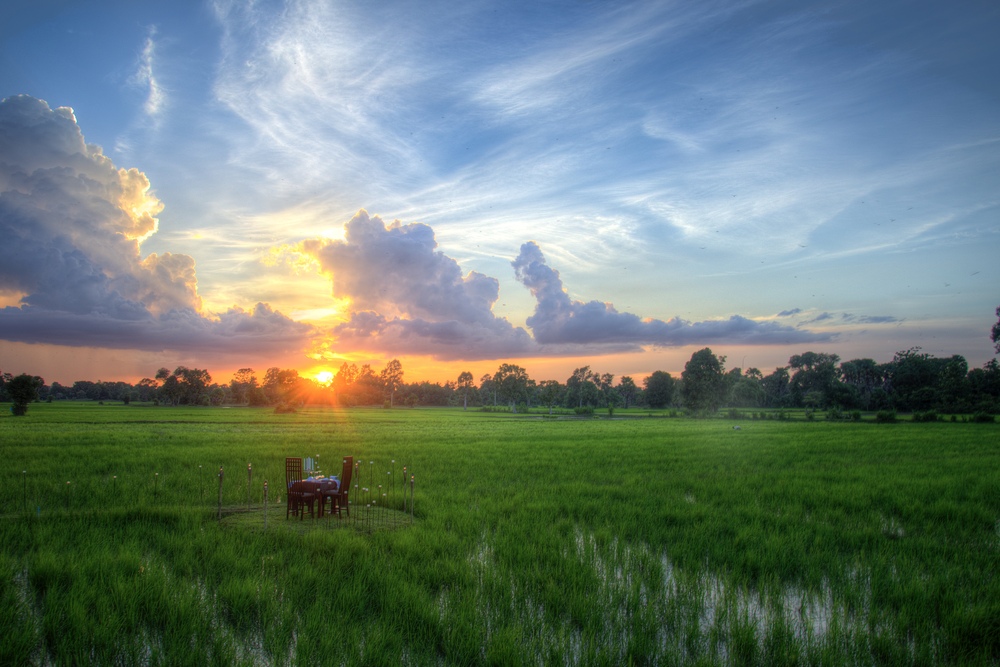
Dine al fresco at Villa Chandara, near Siem Reap. Photo: Ethan Crowley
Villa Chandara is set in a small village on the edge of a quiet village outside Siem Reap. This intimate al fresco dining experience features a five-course traditional fine-dining Khmer menu.
Prime picnic spot
Tad Sae Waterfall, Luang Prabang. Follow the Nam Khan River to a great spot just below this waterfall, a stunning limestone cascade with fluorescent turquoise pools. Here also lies the tomb of the nineteenth-century French explorer Henri Mouhot, the first European to see Angkor Wat and to visit the Royal Kingdom of Luang Prabang. Many Lao people picnic here, so come early on weekends to get a good spot.
Evening buzz
In Siem Reap, drop by Ms. Wong for a pre-dinner cocktail. Set in a narrow shop house, the bar emits an old Shanghai-noir vibe and is a favorite of expats.
Phnom Penh’s Bassac Lane and the the area around Street 308 have developed into a lively zone with plenty of great micro-bars and casual outdoor dining.
In Bangkok, Soi Nana is a network of alleyways on the edge of the Yaowarat Road area (Chinatown) with a collection of hip watering holes. Ethan and Sandy’s favorite is Tep Bar, with its “Old Siam” feel and cocktails featuring local Thai flavors and rice moonshine. This area is excellent for people-watching and is popular with expats and local professionals alike.
Best Time to Go

May/June: You’ll find good weather (and a low chance of rain) in Thailand, Laos, Cambodia, and Vietnam while simultaneously avoiding all peak periods and pricing.
Worst Time to Go
Chinese New Year (or Vietnamese Tet, which is celebrated at the same time, usually late January or early February), when every single tourist attraction is crowded and hotels double their rates. It is a site to behold, but your nerves and wallet will be worse for the wear. Go instead in the weeks leading up to the lunar new year to see preparations being made.
Biggest Rookie Mistake
Trying to put a 50-pound trip into a 30-pound sack! Allow yourself at least two or three nights at each destination; three to four is ideal. Based on this formula, it takes a minimum 28 nights to see Thailand, Laos, Vietnam, and Cambodia—and that’s not counting Myanmar or any beach time.
Instagram Moment
Sunrise or sunset at the ancient Thai city of Sukhothai. Just over 100 miles southwest of Chiang Mai, Sukhothai was the northernmost citadel of the mighty Khmer empire, situated to take advantage of the rise and fall of the sun; today it is a UNESCO World Heritage site. In the early 13th century, a Thai chieftain overthrew the ruling Khmer overlord, making Sukhothai the first independent Thai kingdom. Decades later under the reign of King Ramkhamhaeng, Sukhothai reached the zenith of its power, building a great city whose ruins today encompass a beautifully manicured historical park great for sunset bike rides. There are many vantage points to get some incredible shots, but come out before dawn for the best light.
The Souvenirs
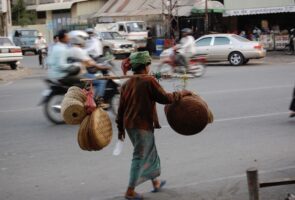
A Cambodian scarf, know as a krama. Integral to Cambodian culture and used for hundreds of daily tasks, these scarves are made from cotton or silk and can be worn by all. The cotton varieties make a casual autumn scarf and the raw silk varieties (in jewel tones) make for a beautiful accessory to evening wear.
For a consumable souvenir, pick up a bottle of Seeker’s Gin, made in Cambodia and the only premium Mekong gin produced from local botanicals.
Scam Alert
“Hello, my friend, are you from America?” Watch out for anyone who approaches you at random speaking excellent English. Most scams in Asia (and particularly Thailand) start with a charming “front” person who will end up luring you to a shop, or maybe some more illicit activity. The most common is a shopping ploy along the lines of “I was just on my way to my uncle’s shop, would you care to come along?“ This most often ends up with you buying counterfeit jewelry or overpriced goods.
Must-Have Apps
Google Translate will translate your text from English to Thai, Lao, Burmese, Khmer, and Vietnamese and vice versa. It’s very easy to use and comes in handy if you are on your own, especially in more rural areas.
Grab Taxi is a rideshare app (partially owned by Uber) and the best way to hail a tuk tuk or cab in Southeast Asia. Simple and intuitive to use, it allows you to avoid unscrupulous drivers.
Airport Intel
The workers who go through your carry-on bags in Bangkok are very conscientious about their jobs and confiscate lots of stuff—so be sure to know what is and isn’t permitted.
Avoid the “freelance taxis” at all airports, and instead take a car service (there are stands in the arrivals hall) or a metered taxi from the taxi queue outside the arrivals area.
If you’re not carrying too much baggage, the fast train from Bangkok’s Suvarnabhumi International Airport to the city center is an easy and convenient way to get to town. It connects to the Skytrain metro system and can save you time as you won’t have to contend with traffic.
Tipping Tip
Give $1 per bag to porters, $5 per night to housekeeping, and a few dollars to restaurant waiters, since this will not be thrown into the tip pool but kept by those who actually served you. In a taxi, round up. You can always use U.S. currency for tips, so take along at least $20 per day in small bills to do that without running out; $2 bills are considered “lucky money” in Southeast Asia.



